How To Set Your Domain_9 Profile To Looking For Work
Microsoft Windows Logon and Domains
![]()
![]()
![]() This article covers Windows 7 and earlier only.
This article covers Windows 7 and earlier only.
![]() Click here for the article on Microsoft Windows 8 Sign-in and Domains.
Click here for the article on Microsoft Windows 8 Sign-in and Domains.
Introduction
On a Microsoft Windows based business organization network, a prepare of computers, shared folders, shared printers, and a list of authorized users and security polices which are all managed together is collectively called a Windows domain, an Active Directory domain, or, most unremarkably, just a domain.
When yous log on to a Windows-based computer that's part of a domain, your calculator will bank check your user name and password against the list of users stored on a type of server called a Domain Controller, also referred to as a logon server. The Domain Controller then grants yous access to the shared folders and printers that your domain user account is authorized to use, regardless of which estimator you logged on from.
All Windows-based computers as well take what are called local user accounts. These are user names and passwords that are known only to your particular computer. Y'all tin can manage these user accounts in your computer's Command Panel. If your figurer is non part of a domain, these are the merely accounts you tin can use to log on. When your figurer is part of a domain, you can either log on with a domain account or using a local user account. While nigh no regular users on a domain network will ever need to log on with a local account, it'south of import to be aware that this is possible.
Anyway, on a computer that is a member of a domain, Windows shows what nosotros will call your logon context at the initial logon screen. This specifies where the user account y'all're going to log on with is located. Then, it will bear witness either the name of a Windows domain, or the proper name of your computer (which would mean local user accounts). If y'all enter your user name and password, but the incorrect context is specified, Windows volition simply tell you that your user name or password is wrong. Windows only checks with the context specified to come across if your user business relationship is in that location and to validate your password. The only manner to log on successfully, then, is to make sure the specified logon context is correct.
Most networks are set up nether one domain, and never have problems with a user selecting the wrong logon context. Once each computer is properly joined to a single-domain network, the logon context is fix to that domain, by default, for every user who tries to log on. As a issue, many users on a stable business concern network never have problems related to selecting the correct domain.
That said, for users on a multiple-domain network, hither is some information on how to deal with potential logon problems related to having the incorrect logon context selected on the initial Windows logon screen.
Selecting Your Logon Context in Windows XP
If you lot have Windows XP on a business network (or still run Windows 2000), your logon screen volition look something similar the motion-picture show below. By default, the logon context is hidden until yous click the Options button.
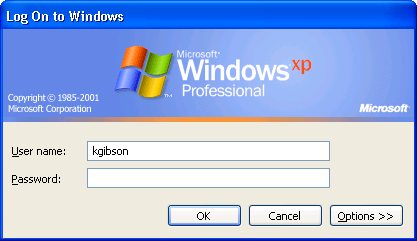
When you click Options, you'll see this:
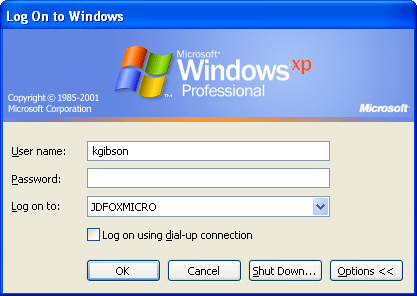
Notice at that place is a drop-down pointer, which you can click to encounter the list of all domains available on your network. 1 of the entries in the listing will be the name of the computer you're on. Windows helpfully lets you know by putting "this computer" on the aforementioned line. Everything else in the list is a domain managed past a Domain Controller. Yous will never run into the name of other figurer workstations or servers hither.
Beneath is an case of a calculator named WORKSTATION4, which is on a network with two domains, named JDFOXMICRO and LAB.
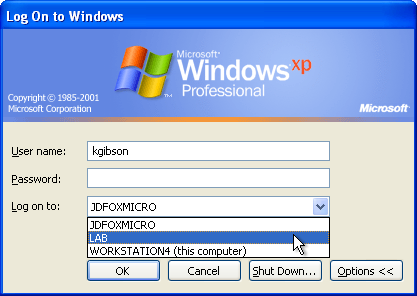
By default, Windows 2000 and Windows XP will be set to the logon context of the concluding user to log on. So if multiple users have accounts on separate domains and share i computer, each user will accept to make sure to manually select the correct domain in the Log on to box.
In the example to a higher place, if the user kgibson only has an account on the LAB domain, he will have to select that in the Log on to box to exist able to log on.
One last note about this verson of Windows: When you lot first click on the drop-downward list to see the list of domains, you lot may get a bulletin that says "Please await while the domain list is created". When this appears, your estimator starts communicating on the network to identify what domains are reachable. This should only take a few seconds. In that location is a quirk, though, where the message won't go away when information technology is finished, and you can sit there staring at your estimator forever waiting for it to say it's done. To make the message go away, printing Ctrl+Alt+Delete. If information technology is actually finished building the domain listing, the message will disappear and you tin can click the drib-downwardly list over again and instantly see the available domains.
Selecting Your Logon Context in Windows Vista and Windows 7
Windows Vista and Windows vii inverse how domains are specified. There is no more drop-downwards listing! The reasons why are complex, but essentially Microsoft made this change in the name of security.
In these newer versions of Windows, if you need to specify a unlike domain than the default, you must now manually type the domain name with your user name, using this syntax: DOMAIN \ USERNAME. Annotation the utilise of the backslash, which is usually in a higher place the Enter key on your keyboard. If the Log on to item is present and already shows the correct domain name, y'all can simply blazon your user name.
Then, accept a look at the near common screen you'll run across when you desire to log on, which shows the user who concluding logged on and prompts for the password:
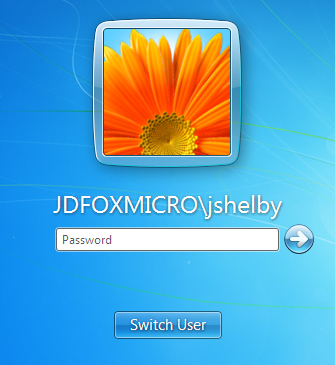
Notice the domain, JDFOXMICRO, is specified clearly here, but you can't edit the domain or the user proper name merely by clicking on it. You must click Switch User and then Other User, just like you do to utilize a different account even on a single-domain network.
Only now you will notice that the logon prompt shows the domain underneath the password box, where it says Log on to. On this screen, Windows Vista and Windows vii always default to the domain that the computer itself is a fellow member of, regardless of who logged in terminal. In this case, the computer is a member of the JDFOXMICRO domain, so that domain however shows here.
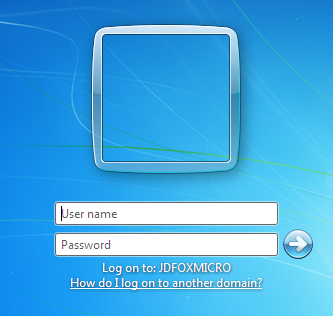
If you need to log on with an account in a different domain, type the domain proper name in the User name box, then a backslash, then your user proper noun on that domain, as shown below. As soon every bit y'all hitting the backslash key, Windows knows you're specifying a domain proper noun, and the Log on to item beneath will alter to evidence what you've typed.
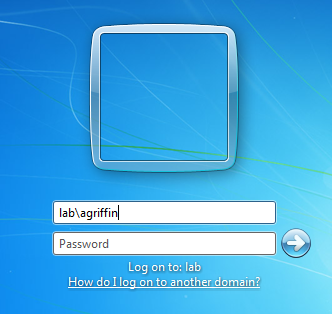
Detect that domain names and user names on Windows networks are not instance-sensitive.
If you ever exercise find yourself having to log on to a domain user account using a computer in a unlike domain, y'all will need to type your domain name every fourth dimension. You cannot but click on it like you could in previous versions of Windows.
Y'all'll notice there is a link labeled "How practise I log on to another domain?" on the above screen. If yous click this, yous volition become this window, which reveals that this item reckoner's name is WORKSTATION2.
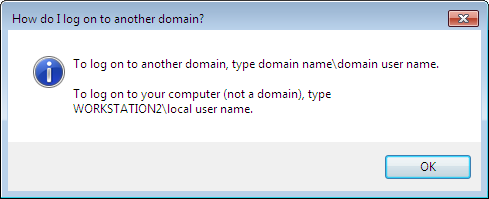
Microsoft's terminology in this window is imprecise and confusing. It incorrectly implies that you aren't logging on to the figurer if you log on through another domain. The whole betoken of all the screens and functions covered so far in the commodity, though, is to log on to a computer, which is what you're doing whether you utilise a domain user account or a local user account. Microsoft besides ignored the fact that yous can merely type a period as a substitute for the computer name. The message in the little box above should actually say something like this:
To log on to this computer using an business relationship from a domain other than the default domain, include the domain name in the user proper name box using this syntax: domain\username.
To log on to this computer using a local user account, precede your local user proper name with a menstruum and backslash, like this: .\username.
There are more quirks you might detect on this detail logon screen, particularly related to local user accounts. But, these are beyond the telescopic of this article, which is meant to focus on logging on to the proper domain account on a standard business network.
Source: https://www.jdfoxmicro.com/resource-center/articles/logging-on-selecting-domain/

0 Response to "How To Set Your Domain_9 Profile To Looking For Work"
Post a Comment